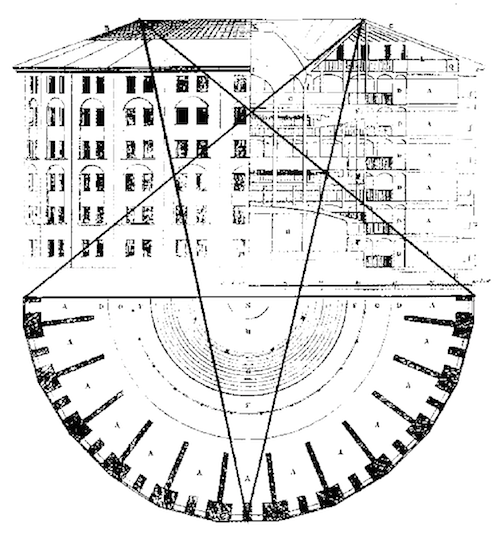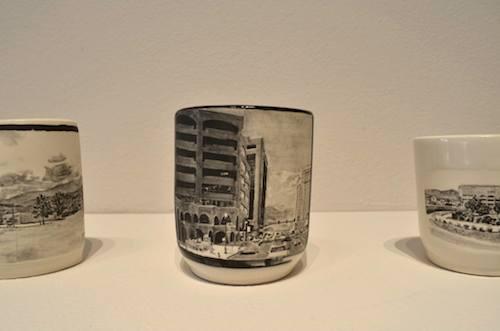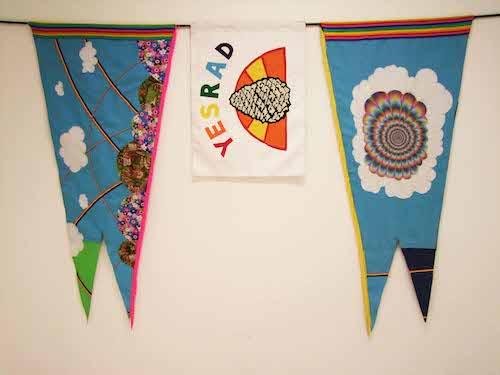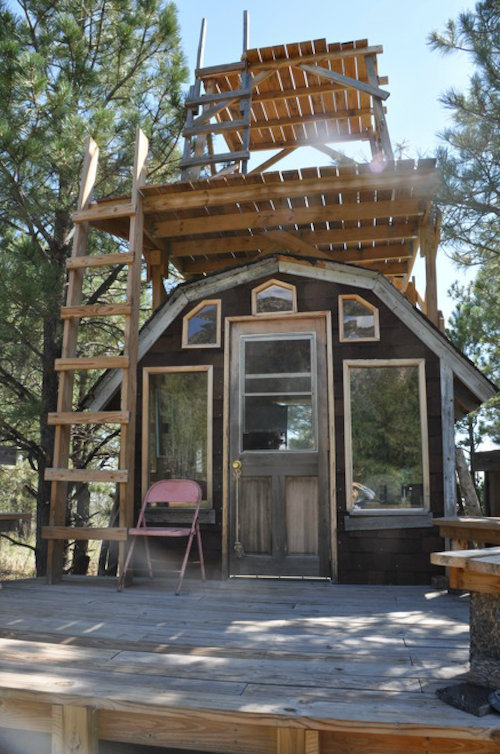Post-Poetry, Part 1: CryptoPo, Part 2: Notes for the Encrypticon
BY Noel Black

This past January, a temporary collective of writers, artists, printers and scholars created a lumpy, hexagonal, cardboard cave inside the small gallery at the back of Mountain Fold Books here in Colorado Springs, which is just a block or so away from the local offices of Booz Allen Hamilton and the FBI, and at the center of a city ringed by The Air Force Academy, Fort Carson, Schriever Air Force Base, Peterson Field, Cheyenne Mountain Air Force Base (nee NORAD) and a dizzying archipelago of military contractors and evangelical churches.
In the wake of the Edward Snowden détournement, a handful of Goonies here had been thinking and talking and making art about the war and surveillance economy’s creepy relationship to Colorado Springs’s infamous landscape and supposed “scenic beauty,” Pikes Peak, Garden of the Gods, etc. Cheyenne Mountain on the southern end of the city, for example, carries the world’s most infamous bunker—a city on springs (boing) built to withstand nuclear attack and track Santa Claus at xmas time—in its womb. I’ve been inside only once, and it’s as impressive a feat of engineering as it is a monument to fear—a kind of Harvey’s Hideout for the ultimate doomsday preppers, our government.
I understand why poets tend to congregate in cities where culture of all kinds is densest, diversity highest, and where ideas circulate more immediately. But it also makes sense on another level that poets and artists would begin to seek out places like Colorado Springs where the living is still easy and the machinations of the empire call for a monkey wrench, if not a monkey, if not a planet of the apes.
Just to give a couple examples of the witchcraft happening here, now:

Artist/Ceramicist Corie Cole recently created a brain-boggling riff on Hokusai’s 36 Views of Mt. Fuji: It’s 36 views of Pikes Peak, but all the views are taken from Google street view and have the buildings of military contractors in the foreground. She then made 36 porcelain Japanese cups and painted the Google-maps images on them in black and white. I know!
Also, artist Matt Barton, who teaches at the University of Colorado at Colorado Springs, set up a compound just an arrow shot away from NORAD on the south slope of Cheyenne Mountain that he calls YESRAD, a site for radical positivity—a serious joke. He even has a flag.

There’s an old Tuff Shed he converted into a studio with a lookout tower that you can climb for a lovely view of Fort Carson. I finished a collection of poems there. (Click HERE and HERE to see more of his compound).

In this vein, a temporary collective of writers, artists, printers and scholars recently created a lumpy, hexagonal, cardboard room inside the small gallery at the back of Mountain Fold Books here in Colorado Springs. The bookstore is just a block away from the local offices of Booz Allen Hamilton and the FBI, and at the center of a city ringed by The Air Force Academy, Fort Carson, Schriever Air Force Base, Peterson Field, Cheyenne Mountain Air Force Base (nee NORAD) and a dizzying archipelago of military contractors and churches.
The idea was to create a machine for deauthor/iz/ed poetry, a kind of public key exquisite corpse—a hadron collider for public privacy particles—whether poetry could create the conditions for privacy, or act as a form of encryption, something most believe it already does where “meaning” is concerned.
Poetry has a small, if not venerable tradition as a tool of spycraft. The British were using well-known (easy to memorize) poems as transposition ciphers during WWII. But, because the poems were often too well-known, they were vulnerable, especially if used more than once. As recounted in his memoir Between Silk and Cyanide. British SOE agent Leo Marks began writing original poems as encryption keys that would be easy to memorize, but unavailable to cryptanalysts. The most famous example of this is Marks’s poem “The Life That I Have."
The Encrypticon, too, could be used as a form of public-key encryption if one were to need, or want to use it for that, but I’ll get to that later. Here’s how the event went:
1). Everyone in the audience was asked to turn off any electronic devices and drop them in a basket that was then covered in aluminum foil. It was presumed that someone from the FBI was inside the room
2). Instructions were given: Each person in attendance could spend one minute inside The Encrypticon, or not. Once the minute was up, we rang a bell, the person left the structure and entered a “debriefing room”/space adjacent to The Encrypticon where further instructions were written down. At the same time, another person entered The Encrypticon. People were free to talk, but couldn't talk about what happened inside The Encrypticon.
3). Behind the walls of the cardboard walls of The Encrypticon, 6 of Encryptors were stationed at 6 holes at 6 difference places around the perimeter. (Each hole had a cardboard tube attached to it to make it easier for the Encryptors/readers to read). Part of the following texts were used as :
-The iPhone user agreement
-Guantanamo by Frank Smith, translated by Vanessa Place
-The Senate Intelligence Committee’s CIA Torture Report
-Communism is up there and we're down here but it's happening now by Olive Blackburn
-Discipline and Punish, Foucault
-Casino Royale by Ian Fleming
-1984 by George Orwell
5). The following text was read:
The encrypticon is the poem, but it’s not for you, Aunt Linda.
It is the author; not you.
It’s a panopticon tube snake, frankly — a cardboard institution.
OuroborousuoroboruO — Cobra Goddess Cult Confessional.
Basically it’s block-chain privacy perversion, mental masturbation all the way.
The concept of the design is to allow a person to experience abject privacy: canned sentimentality, ham-fisted propaganda, pornographic clichés, poetry.
To be seen, but disunderstood.
To be an inmate of silence, unseen, physically impossible, all cells at once.
Unwatched means that all inmates must act at all times, effectively uncontrolling the behavior of the listener/watchman.
And thus a hundred eyes made blind by Nob’dy.
The design consists of a circular structure with inmates stationed around the perimeter in a vagina of time, a new mode of obtaining power of mind over prison.
The Encrypticon is not the opposite of the panopticon, but its apposite.
Although it is physically impossible for the single poet/prisoner to speak at once for everyone, the fact that the listener cannot know when they are being spoken for means that all poets must act as though they are speaking for everyone at all times, without ever controlling any one part of the poem/Encrypticon, ever.
Technology of any kind is prohibited, freeing the poets-speakers and the listener-poets to experience a state of anti-surveillance, pure, unobserved internality.
All formal considerations/distinctions (narrativity vs. parataxis, experient vs. quietude, male vs. female, and other such binaries) shall be subsumed and sublimated by the cardboard form and anonymity structure of The Encrypticon.
The Encrypticon is "a new mode of losing power of mind over mind." It is "a mill for grinding surveillance into privacy".
The Encrypticon, because none can own or control it, will serve as antidote to the “reactionary germ cell” and other forms of fascism peculiar to the authori-tized/authorized mind.
The Encrypticon has none, nor can it have, any authority.
The poem/s that emerge from The Encrypticon will be, effectively, anonymized, authorless, and unattributable to any individual.
As the listeners cannot see the speakers, nor reliably document their words with any authority, the listener is freed of all responsibility. She is free, finally, to write without authorship.
Again: To write without authorship. Poet/s as hidden reader. Poem as plurality, collective momentivity.
Again: The Encrypticon is a cheap, piece of shit liberation machine, designed to permanently remove the author from the writing of poems.
6). Volunteers from the audience came up one-by-one, spent their minute in The Encrypticon listening to the 6 voices (the tubes into which they were voices spoke were lit up with little colored LED lights). Then they went into the “debriefing room” next to it where there was a sheet of paper with instructions to write down everything they could remember from what they experienced in The Encrypticon in one minute. Those papers were folded, put into a box, the next person came in, etc. until everyone who wanted to participate made it through.
There were about 50 people there and the whole thing took about an hour.
Then, we took out all the papers, arranged them in no particular order, and read the responses aloud. This is the point at which it would be easy to transmit a cipher or code. The person reading could easily insert an extra sheet of paper, or simply add extra text indicated by a physical cue shared only by the two parties. It’d be an enormous labor to go through to transmit a message that can be communicated by infinitely more secure and expeditious means.
While the collectively generated text itself was interesting (New Lights Press has asked to publish it, though I’m not sure it should be published), it was what happened in the bookstore while the crowd made its way through The Encrypticon that was most unexpected: People talked to each other for an hour without the intermediation of phones/cameras/internet/etc. We hadn’t even thought about these interactions as a possible outcome of this highly structured, de-mediated ritual. As with the experience surrounding the Anti-Surveillance Feminist Poet Hair & Makeup Party (which I wrote about HERE, and which would be fun to do in conjunction with The Encrypticon), it wasn’t The Encrypticon, but the conditions of privacy/anti-surveillance it created (free from intention or authorship) that generated what might be called the poem.
Poet, publisher, translator, and radio producer Noel Black was born in Tucson, Arizona and grew up in...
Read Full Biography

